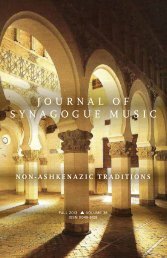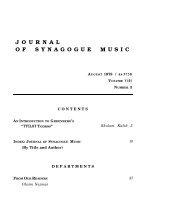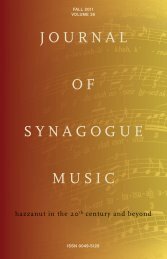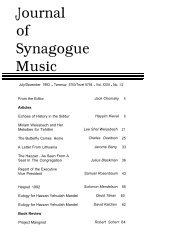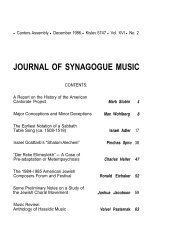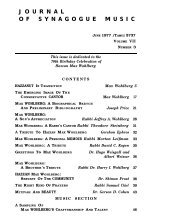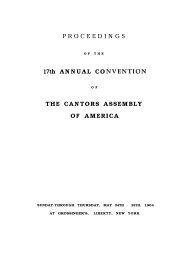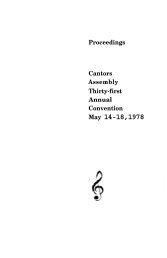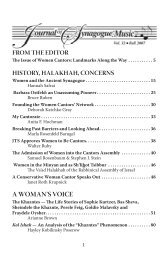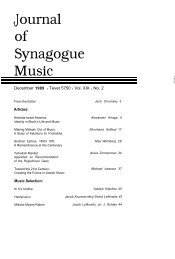ninth annual conference-convention - Cantors Assembly
ninth annual conference-convention - Cantors Assembly
ninth annual conference-convention - Cantors Assembly
You also want an ePaper? Increase the reach of your titles
YUMPU automatically turns print PDFs into web optimized ePapers that Google loves.
chorus. He continued in this post until Low’s return,<br />
another testimonial to his ability.<br />
He is also represented by two selections in the very<br />
worthy volume “Synagogue Music of Contemporary<br />
Composers” (Schirmer) , an anthology for the Sabbath<br />
Eve Service. This book, conceived by Cantor<br />
David Putterman, is dedicated to the enhancement of<br />
Jewish worship and “to the encouragement of those<br />
who give of their lives and genius to the enrichment<br />
of that music”. With respect to Zilberts, these are<br />
fitting words indeed. Compositions by Zilberts are<br />
also to be found in each of the first four volumes of<br />
the Cantorial Anthologies by Gershon Ephros. In<br />
view of the number of publications to Zilberts’ credit,<br />
it is surprising that in Gdal Saleski’s book “Famous<br />
Musicians of Jewish Origin”, only a mere listing of<br />
Zilberts’ name is made as a composer, although the<br />
author does give considerable space to his activities<br />
as conductor<br />
The admirers of Zavel Zilberts and his music are<br />
legion. Besides all those who sang and are still singing<br />
his music, and those whom he conducted, there<br />
are the hundreds of thousands of people who, through<br />
the years, received musical enjoyment from his concerts.<br />
But there is one admirer who stands out above all.<br />
A great debt of gratitude and thanks is due Hyman<br />
Fliegel, who has been truly devoted to the cause of<br />
Zilberts’ music. An attorney by profession, “Hy”, as<br />
he is affectionately known, is today one of the most<br />
active workers in the Zilberts Choral Society, now<br />
under the musical guidance of the able and talented<br />
Seymour Silbermintz. I am personally indebted to<br />
Hy Fliegel for the material he has made available<br />
to me, also to Eric Mandell (Philadelphia) for some<br />
valuable points of information.<br />
Congratulations and compliments are due the <strong>Cantors</strong><br />
<strong>Assembly</strong> for the acquisition of the manuscripts<br />
of the unpublished works of Zavel Zilberts. This most<br />
valuable treasure of Jewish music will not now be<br />
lost, as has happened in many cases of deceased Jewish<br />
composers of established reputation. And the remuneration<br />
to Mrs. Zilberts will help her somewhat in<br />
her not-too-comfortable state of existence.<br />
My thanks to the <strong>Assembly</strong> and Hazzan Putterman<br />
for the gracious invitation and opportunity to state<br />
some facts and opinions, and reminisce, about a great<br />
composer. All the friends he made for Jewish music<br />
will long remember ZAVEL ZILBERTS.<br />
HOW CAN THE ANCIENT HEBREW<br />
MELOS BE RESTORED?<br />
by DR. JOSEPH YASSER<br />
Faculty Member, <strong>Cantors</strong> Institute<br />
The idea that the ancient Hebrew melos can ever<br />
be scientifically restored, even in a relatively limited<br />
way, is usually met with a good deal of skepticism, to<br />
- 30 -<br />
say the least. More often than not, such a possibility<br />
is regarded as manifestly hopeless, and any venture<br />
in this direction as idle and even fantastic. And yet,<br />
in this mighty chorus of almost universal doubt, one<br />
sometimes hears a few individual but persistent voices<br />
which do not tire of claiming that, in part at any<br />
rate, the ancient Hebrew melos has a serious chance<br />
of a reasonably adequate restoration.<br />
The claim of these undaunted voices-which, incidentally,<br />
I have never hesitated to join-is largely<br />
based on the fact that there exists an impressive<br />
melodic resemblance between some of the extant and<br />
presumably old specimens of Hebrew and Christian<br />
chants which since their early segregation from each<br />
other have come down to us through entirely independent<br />
historical channels. This resemblance, needless<br />
to say, does not represent, as a rule, anything<br />
like complete identity. But even so, it cannot help<br />
giving us a general assurance that the fundamental<br />
stock of ancient Hebrew melodies, whatever their present<br />
state, has not been wholly lost. Such an assurance<br />
is indeed the main prerequisite for any attempt at<br />
reconstructing the orignal form of these melodies,<br />
whose appearance, naturally, was bound to be altered<br />
-sometimes considerably so-in the course of a long<br />
history.<br />
What is more, the very fact that the Hebrew and<br />
Christian versions of the same chants merely resemble<br />
each other, and are not absolutely identical, should<br />
be looked upon from the scientific angle as an advantage<br />
rather than otherwise. For the variations that<br />
may be observed at many points of these chants afford<br />
us a certain insight into the very mechanism of<br />
the changes which have been effected-consciously or<br />
not-by individual Hebrew and Christian performers<br />
at different historical stages. As a matter of fact,<br />
these melodic changes represent, in a great many<br />
cases, no more than ornate elaborations of simpler<br />
motifs incorporated in the chants and developed after<br />
more or less similar patterns. Such similarity would<br />
seem to indicate that certain common laws of inner<br />
musical logic have been at work during this long<br />
transformative process ; a circumstance that in no<br />
small measure helps to rationalize our problem and<br />
thus inspires additional hope for its successful solution.<br />
This being so, one may well imagine what new and<br />
other changes within the Hebrew and Christian liturgical<br />
chants be thoroughly studied and then systematically<br />
classified according to their characteristic types.<br />
It is indeed quite evident that the resulting list--or<br />
rather a veritable codex of vast proportions-could<br />
readily serve as a sort of universal key for the melodic<br />
restoration scrutinized in the present discussion.<br />
To be more specific, the individual entries of such a<br />
‘codex’, showing the most typical and frequent instances<br />
of transformation from simple to complicated motifs,<br />
could be applied in reverse order, as it were, to<br />
various places in any traditional chant, whose earlier<br />
and more primitive forms one might wish to restore.<br />
Let me illustrate this point by means of a very simple<br />
and purely theoretical example.



